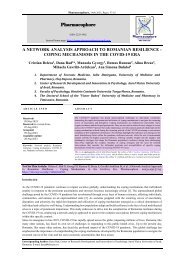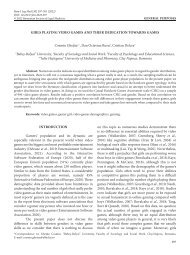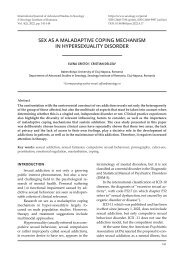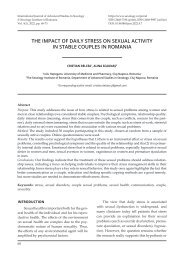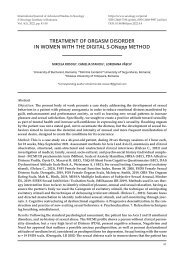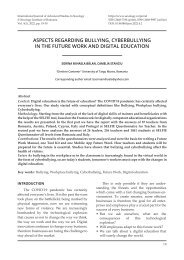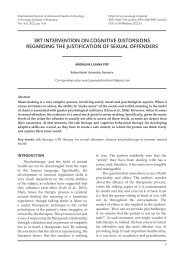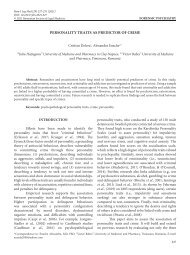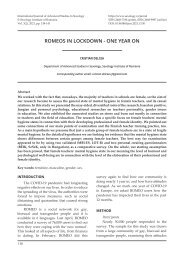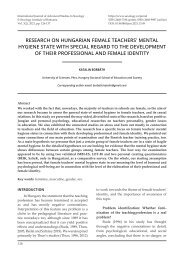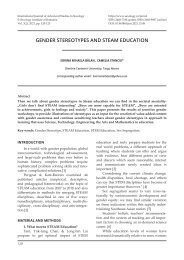Testing the effectiveness of an online CBT intervention with the S-ONapp method for both partners to reduce postpartum female sexual disorders
Objective: The research evaluates the effectiveness of an online CBT program through the S-ONapp method addressed to both partners in order to decrease female sexual problems and increase the sexual satisfaction of both partners in the postpartum period. Method: In a randomized clinical trial, participants - women in the first 3 months postpartum with sexual problems revealed by FSFI scale scores - were randomly assigned to two groups: experimental group (CBT online intervention for both partners) and control group (intervention CBT online standard for women). For both groups, scores on the FSFI (female sexual disorder), NSSS-S (sexual satisfaction) scales for both partners, and DAS (couple satisfaction) scales for both partners are measured on pretest, posttest, and 6-month follow-up. Expected results: Regarding the control group, we expect that in the experimental group there will be: 1) a lower level of postpartum sexual problems reported by women in the posttest; 2) a higher level of sexual satisfaction reported by women in the posttest; 3) a higher level of sexual satisfaction reported by partners in the posttest; 4) a higher level of couple satisfaction reported by women in the posttest; 5) a higher level of couple satisfaction reported by partners in the posttest. The results are maintained 6 months after the intervention. Conclusions: An online CBT intervention program for both partners, based on a multidimensional approach to postpartum female sexual problems, is effective in improving the sexual life of both partners by increasing sexual satisfaction and couple satisfaction, with direct implications for the clinical field.
Objective: The research evaluates the effectiveness of an online CBT program through the S-ONapp
method addressed to both partners in order to decrease female sexual problems and increase the sexual satisfaction of both partners in the postpartum period. Method: In a randomized clinical trial, participants - women in the first 3 months postpartum with sexual problems revealed by FSFI scale scores - were randomly assigned to two groups: experimental group (CBT online intervention for both partners) and control group (intervention CBT online standard for women). For both groups, scores on the FSFI (female sexual disorder), NSSS-S (sexual satisfaction) scales for both partners, and DAS (couple satisfaction) scales for both partners are measured on pretest, posttest, and 6-month follow-up.
Expected results: Regarding the control group, we expect that in the experimental group there will be:
1) a lower level of postpartum sexual problems reported by women in the posttest; 2) a higher level of
sexual satisfaction reported by women in the posttest; 3) a higher level of sexual satisfaction reported
by partners in the posttest; 4) a higher level of couple satisfaction reported by women in the posttest;
5) a higher level of couple satisfaction reported by partners in the posttest. The results are maintained
6 months after the intervention.
Conclusions: An online CBT intervention program for both partners, based on a multidimensional
approach to postpartum female sexual problems, is effective in improving the sexual life of both partners by increasing sexual satisfaction and couple satisfaction, with direct implications for the clinical field.
Create successful ePaper yourself
Turn your PDF publications into a flip-book with our unique Google optimized e-Paper software.
<strong>Testing</strong> <strong>the</strong> <strong>effectiveness</strong> <strong>of</strong> <strong>an</strong> <strong>online</strong> <strong>CBT</strong> <strong>intervention</strong> <strong>with</strong> <strong>the</strong> S-<strong>ONapp</strong> <strong>method</strong> <strong>for</strong> <strong>both</strong> <strong>partners</strong><br />
First meeting:<br />
The second session:<br />
The third session:<br />
Fourth meeting:<br />
Fifth meeting<br />
Sixth session:<br />
Table 1. The structure <strong>an</strong>d content <strong>of</strong> <strong>the</strong> <strong>intervention</strong> program<br />
motivation <strong>for</strong> treatment <strong>an</strong>d proposal <strong>of</strong> objectives, roles,<br />
responsibilities, priorities, flexible time<br />
<strong>the</strong> psychoeducation <strong>of</strong> <strong>female</strong> <strong>an</strong>d male <strong>disorders</strong><br />
dealing <strong>with</strong> perceptual issues<br />
Social support<br />
<strong>the</strong> couple’s relationship<br />
<strong>sexual</strong> activity<br />
necologists, clinics, hospitals, social media.<br />
Patients are invited <strong>to</strong> complete <strong>the</strong> in<strong>for</strong>med<br />
consent <strong>an</strong>d FSFI. They also complete <strong>an</strong> additional<br />
questionnaire <strong>with</strong> demographics <strong>an</strong>d<br />
o<strong>the</strong>r in<strong>for</strong>mation <strong>to</strong> identify whe<strong>the</strong>r <strong>the</strong> patient<br />
is eligible from <strong>the</strong> perspective <strong>of</strong> <strong>the</strong> o<strong>the</strong>r<br />
inclusion <strong>an</strong>d exclusion criteria.<br />
Eligible patients <strong>with</strong> a score below 26 on<br />
FSFI are invited <strong>to</strong> participate in <strong>the</strong> study.<br />
Selected particip<strong>an</strong>ts are r<strong>an</strong>domly assigned<br />
(1: 1 allocation rate) <strong>to</strong> one <strong>of</strong> two<br />
groups: <strong>the</strong> experimental group (<strong>CBT</strong> <strong>online</strong><br />
<strong>intervention</strong> <strong>for</strong> <strong>both</strong> <strong>partners</strong>) <strong>an</strong>d <strong>the</strong> control<br />
group (st<strong>an</strong>dard <strong>online</strong> <strong>CBT</strong> <strong>intervention</strong><br />
<strong>for</strong> women). For <strong>both</strong> groups, particip<strong>an</strong>ts <strong>an</strong>d<br />
<strong>the</strong>ir <strong>partners</strong> complete <strong>the</strong> NSSS-S <strong>an</strong>d DAS<br />
(Table 1).<br />
The <strong>online</strong> <strong>CBT</strong> <strong>the</strong>rapy program <strong>for</strong> <strong>both</strong><br />
<strong>partners</strong> is accessed from <strong>the</strong> computer or mobile<br />
devices, individually by <strong>the</strong> two <strong>partners</strong>.<br />
The program contains 6 modules, which will be<br />
completed in 6 weeks. Each module ends <strong>with</strong><br />
a questionnaire <strong>to</strong> assess <strong>the</strong> degree <strong>of</strong> underst<strong>an</strong>ding<br />
<strong>an</strong>d assimilation <strong>of</strong> <strong>the</strong> in<strong>for</strong>mation<br />
presented, along <strong>with</strong> a homework. The <strong>online</strong><br />
program has built-in <strong>to</strong>ols that make it easy<br />
<strong>an</strong>d pleas<strong>an</strong>t <strong>to</strong> navigate through <strong>the</strong> in<strong>for</strong>mation,<br />
reminders <strong>to</strong> do homework, feedback immediately<br />
after completing <strong>the</strong> questionnaires<br />
<strong>an</strong>d indications on which in<strong>for</strong>mation needs <strong>to</strong><br />
be returned. The in<strong>for</strong>mation will be available<br />
in <strong>both</strong> text <strong>an</strong>d audio, making it easier <strong>to</strong> navigate<br />
based on preference <strong>an</strong>d availability.<br />
After completing <strong>the</strong> <strong>intervention</strong>, in week<br />
7, <strong>the</strong> particip<strong>an</strong>ts complete <strong>the</strong> FSFI, NSSS-S<br />
<strong>an</strong>d DAS scales, obtaining <strong>the</strong> posttest results.<br />
Also, after 6 months from <strong>the</strong> end <strong>of</strong> <strong>the</strong> <strong>intervention</strong>,<br />
<strong>the</strong> particip<strong>an</strong>ts complete <strong>the</strong> FSFI,<br />
NSSS-S <strong>an</strong>d DAS scales again, obtaining <strong>the</strong><br />
follow-up results.<br />
Expected results<br />
For <strong>the</strong> verification <strong>of</strong> each hypo<strong>the</strong>sis,<br />
a mixed 2x3 ANOVA is used, applied <strong>to</strong> <strong>the</strong><br />
results FSFI, NSSS-S <strong>for</strong> women, NSSS-S<br />
<strong>for</strong> men, DAS <strong>for</strong> women, DAS <strong>for</strong> men,<br />
respectively. We expect <strong>the</strong> scores <strong>of</strong> <strong>the</strong><br />
dependent variables <strong>to</strong> be signific<strong>an</strong>tly different<br />
between <strong>the</strong> groups depending on <strong>the</strong> time<br />
<strong>of</strong> measurement. To locate <strong>the</strong>se signific<strong>an</strong>t<br />
differences, complementary statistical <strong>an</strong>alyzes<br />
will be per<strong>for</strong>med using <strong>the</strong> Tuckey HSD test.<br />
We expect that: a) <strong>the</strong> scores <strong>of</strong> <strong>the</strong> dependent<br />
variables will be signific<strong>an</strong>tly higher in <strong>the</strong><br />
posttest in <strong>the</strong> case <strong>of</strong> <strong>the</strong> experimental group<br />
th<strong>an</strong> in <strong>the</strong> case <strong>of</strong> <strong>the</strong> control group; b) <strong>the</strong><br />
scores <strong>of</strong> <strong>the</strong> dependent variables will be<br />
signific<strong>an</strong>tly higher from posttest <strong>to</strong> followup<br />
in <strong>the</strong> case <strong>of</strong> <strong>the</strong> experimental group; c)<br />
<strong>the</strong> scores <strong>of</strong> <strong>the</strong> dependent variables will be<br />
signific<strong>an</strong>tly higher at follow-up in <strong>the</strong> case<br />
<strong>of</strong> <strong>the</strong> experimental group th<strong>an</strong> those <strong>of</strong> <strong>the</strong><br />
control group. Given <strong>the</strong> expected results, <strong>the</strong><br />
study will provide empirical evidence <strong>to</strong> show<br />
that <strong>CBT</strong> <strong>intervention</strong> <strong>for</strong> <strong>both</strong> <strong>partners</strong> leads <strong>to</strong><br />
a post-test reduction <strong>of</strong> <strong>female</strong> <strong>sexual</strong> problems,<br />
increased <strong>sexual</strong> <strong>an</strong>d couple satisfaction <strong>of</strong><br />
<strong>both</strong> <strong>partners</strong> in <strong>the</strong> <strong>postpartum</strong> period, which<br />
are maintained 6 months after <strong>the</strong> <strong>intervention</strong>.<br />
CONCLUSIONS<br />
Previous studies on <strong>intervention</strong>s <strong>for</strong><br />
<strong>female</strong> <strong>sexual</strong> <strong>disorders</strong> in <strong>the</strong> <strong>postpartum</strong><br />
period have revealed several aspects that<br />
were <strong>the</strong> starting point <strong>for</strong> this research: a)<br />
<strong>online</strong> <strong>intervention</strong>s eliminate time barriers,<br />
flexibility characteristic <strong>of</strong> <strong>the</strong> <strong>postpartum</strong><br />
period; b) <strong>online</strong> <strong>CBT</strong> <strong>intervention</strong>s are<br />
effective in treating <strong>female</strong> <strong>sexual</strong> problems; c)<br />
<strong>female</strong> <strong>sexual</strong> problems should be addressed<br />
79




